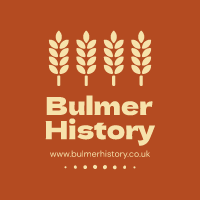Bulmer must have admired the transformation of these corrugated iron roofed cottages in Bulmer Street, now that Phil Rowe has renovated them (September 2006). During his work some very ancient documents were discovered, and Peter Rowe has painstakingly examined these documents. The following reveals a wonderful piece of village history.
The building dates, I think, from around 1550 - 1600. Initially built as one dwelling, for someone of some means (at that time brick chimneys were only for the rich) it subsequently became divided and extended until, at one time, it became 4 cottages. This is how it was when the tin roof was constructed over the top of the old thatch in 1900, carried out by the estate carpenter of Goldingham Hall, although the Goldingham estate were not the owners.
Some ancient deeds fill in a lot of the history of the cottages the earliest being dated 1685. Then two cottages, owned by Anne Brand, a widow, of Belchamp Otten, she passed them on to John Brand, probably her son, for £24. In 1704 John sold them to William Hawkins, wheelwright, of Bulmer for £55. By this time there were three "messuages or tenements under one roof". It's almost certain that John Brand had extended on to the left hand side. The tenants were Daniel Kingsbury, John Johnson and Thomas Butcher.
The story now gets interesting, in 1717 William Hawkins takes a £50 mortgage, from one Samuel Dale of Braintree, Apothecary, possibly to enable him to build his Wheelwrights shop and set up in business. Dale, who was 57 at the time, was a very keen botanist and a close friend of the famous John Ray of Braintree, "The father of botanic science". Another colleague of Dales, was apothecary and botanist Joseph Andrews of Sudbury, whose preserved plant collection is the oldest in existence in the Natural History Museum, in London. For more details on these two and to see a painting of them, see Ashley Cooper's book Our Mother Earth.
Dale didn't collect any interest on the loan till 1722, when he received £3 "in part interest" Various amounts were paid up to 1727, when we read "allowed towards boarding my daughter 50 shillings". Another four payments of 50 shillings were acknowledged, "against lodging my daughter" the last in 1729. By that date Dale was almost seventy. Had he a younger wife, or was he still supporting a spinster daughter, or was there a child he had to keep quiet about? Remember, Bulmer was well out of the way from Braintree in the horse and cart era! Whatever the explanation, in 1730 Hawkins sells the property to Robert Butcher, Blacksmith of Bulmer, for £80, but remained living there himself. It is obvious that he had hit on hard times. Between 1717 and 1730 the interest on the £50 loan amounted to £25.5.s, the equivalent of just under 4% per annum, without compound.
1735 sees Robert Butcher buying an orchard, adjacent to the cottages, from John King, senior and John King junior, collar makers of Castle Hedingham. Having studied these deeds and the 1840 tithe map, it is clear that the orchard is now the site of our home, "Cornfields" and "The Bungalow" of Maudie Rowe.
In 1763 Butcher, now described as a farmer and maltster, had really prospered. He owned 30 acre Church Field in Bulmer, a farmhouse, a farm in Wickham St.Pauls, as well as property in Belchamp Otten, Cavendish and Glemsford. The copy of his will is fascinating. He had 4 sons and the Street cottages were left to his son James.
1785 James Butcher (now of Saling Essex) sells to William Ray clockmaker of Sudbury, for £65 the occupiers then, were James Lofts, Harry Row (have we gained an "e"since then?) and Isaac Coot.
1786 William Ray sells to joint owners, James Nelson husbandman, of Bulmer and Thomas Flower the elder cordwainer (shoe maker) of Lazell (Lawshall?) Suffolk, for £75. Then in the occupation of James Montague, John Dixey and Isaac Coot. Nelson and Flower each lived in one of the cottages and each had a half share in the wheelwrights shop of George Daniels, who presumably lived in the third cottage.
1800 Severance of joint tenancy, Flower sells his part to John Cooper of Great Cornard. His cottage then consisted of "One lower room and buttery with two sleeping or upper rooms".
1818 Nelson and Cooper sell to Thomas Pung, But each of them remain in their cottages. They get £40 each. Pung owned Blackhouse Farm, but probably didn't live in Bulmer.
1851 Pung dies, occupiers were then Thomas Shorten, Robert Moss and George Daniels.
The cottages were then sold to Abraham Mayes, innkeeper (Blackbirds) for £320. He already owned what are now Chapel Cottages and had the two pairs of flint cottages built around 1850. He was one of the overseers of the poor for Bulmer at one time.
1865 Mayes sells to Samuel Brown a butcher of Sudbury, for £300. Described as "All those 4 messuages under one roof (formerly 3) with the wheelwrights shop etc. Now in the occupation of William Daniels, Robert Blandon, Samuel Barrell and Mark Searles".
1880's Brown dies and leaves the cottages between his four spinster daughters. The last remaining one, Alice Brown, died in or about 1928. The cottages were only a small part of her estate; it also included 2 shops 10 cottages and a house, and all in Sudbury. They were all auctioned at The Four Swans Sudbury, in 1928.
The cottages were knocked down to Albert Rowe, Phil's great grandfather, for £120. Albert's brother Jim occupied two, P.Younger and Sam Searle occupied the other two.
The thatchers addition to the roof was a Turkey in recognition of Phil's family association with Turkey farming, which has now been removed and can be seen on the roof of a garage at the end of the Street.

